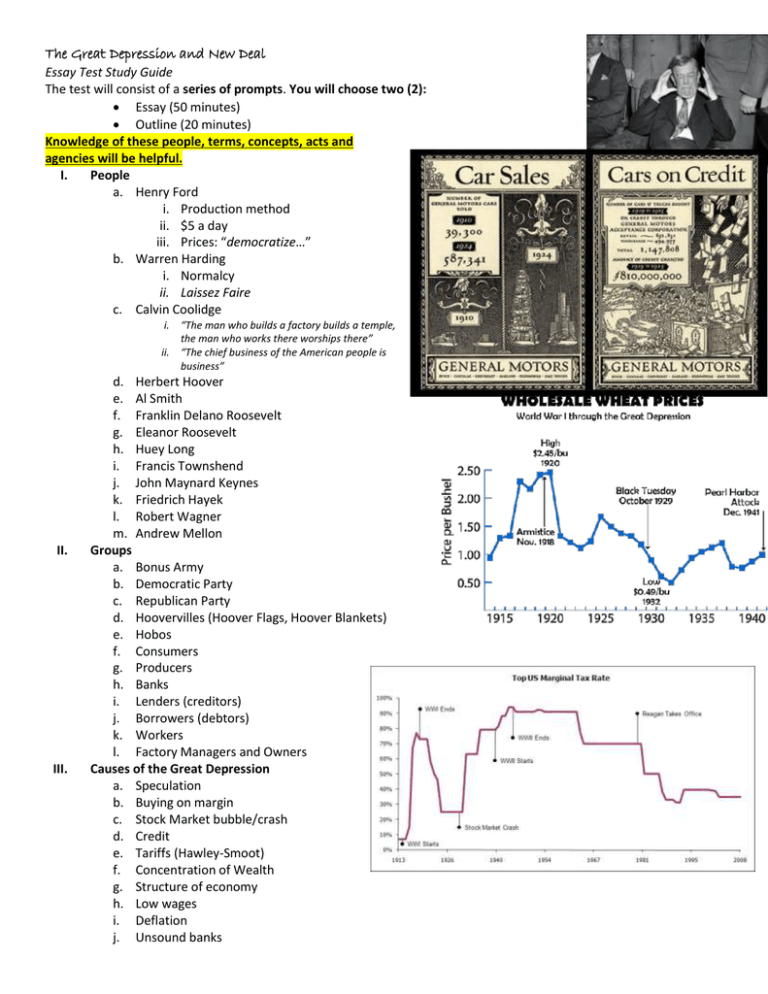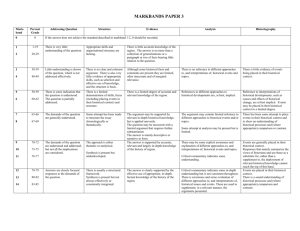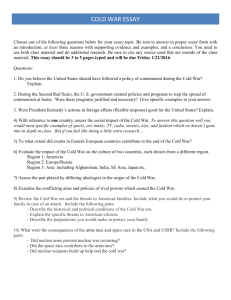The Great Depression and New Deal Study Guide
advertisement

The Great Depression and New Deal Essay Test Study Guide The test will consist of a series of prompts. You will choose two (2): Essay (50 minutes) Outline (20 minutes) Knowledge of these people, terms, concepts, acts and agencies will be helpful. I. People a. Henry Ford i. Production method ii. $5 a day iii. Prices: “democratize…” b. Warren Harding i. Normalcy ii. Laissez Faire c. Calvin Coolidge i. ii. II. III. “The man who builds a factory builds a temple, the man who works there worships there” “The chief business of the American people is business” d. Herbert Hoover e. Al Smith f. Franklin Delano Roosevelt g. Eleanor Roosevelt h. Huey Long i. Francis Townshend j. John Maynard Keynes k. Friedrich Hayek l. Robert Wagner m. Andrew Mellon Groups a. Bonus Army b. Democratic Party c. Republican Party d. Hoovervilles (Hoover Flags, Hoover Blankets) e. Hobos f. Consumers g. Producers h. Banks i. Lenders (creditors) j. Borrowers (debtors) k. Workers l. Factory Managers and Owners Causes of the Great Depression a. Speculation b. Buying on margin c. Stock Market bubble/crash d. Credit e. Tariffs (Hawley-Smoot) f. Concentration of Wealth g. Structure of economy h. Low wages i. Deflation j. Unsound banks IV. V. k. Overproduction l. Agricultural issues i. Dust Bowl ii. Debt, Prices m. Psychology (get rich quick, keep up w/joneses, bank runs, insecurity…) n. Low aggregate demand o. Economic insecurity Concepts, ideas and issues a. Statistics b. Social costs c. Collective bargaining d. Strikes (Seattle, San Francisco, Gastonia…) e. Supply f. Demand g. Monetary policy h. Gold Standard i. Prohibition j. Demand shifts i. What can raise demand? ii. What can lower demand? k. Affect of demand on price l. Affect of price on supply m. Affect of supply and demand changes on people (consumers/producers) n. Comparison to Germany/Hitler o. “Soak the Rich” p. Elections: 1932, 1936 i. Political changes q. Social changes r. Minorities i. Mexican Americans ii. African Americans iii. Native Americans s. Human migration t. Okies u. Hoover’s recovery policies v. Earlier economic downturns The New Deal (know, describe and explain specific policies/agencies) a. FDR Quotes/economic attitude b. 100 Days c. 1st New Deal d. 2nd New Deal e. End Prohibition f. Abandon Gold Standard g. Bank Holiday h. 1st Inaugural: i. Nothing to fear… ii. War metaphor iii. blame i. Fireside Chats j. Relief i. Examples k. Recovery i. Examples l. Reform i. Examples m. Regional Planning n. Unions o. Farm policy p. Economic security i. Examples q. Opposition to i. Courts ii. Huey Long iii. Townsend Plan iv. Father Coughlin v. Wealthy people (Hearst; “…I welcome their hatred”) r. Court Packing Plan and public reaction s. Legacy of the New Deal t. Ongoing debates Marks 0 1–2 3–4 Level descriptor Assessment objectives and mark range The work does not reach a standard described by the descriptors below. Low mark range: Answers lack understanding of the demands of the question or accurate/relevant historical knowledge. Answers show little or no evidence of structure and consist of little more than unsupported generalizations. Answers reveal little understanding of the question. While historical details are present, they are largely inaccurate and/or of marginal relevance to the task. Economic, political, and/or social terms and issues not adequately addressed. There is little or no understanding of historical context or historical processes. While there may be a recognizable essay structure, answers consist of little more than poorly substantiated assertions. 5–6 Answers indicate some understanding of the question. There is some relevant, accurate historical knowledge but detail is insufficient. Understanding of historical processes and (where appropriate) comparison and contrast may be present but underdeveloped. Economic terms present, economic analysis attempted; lacks discussion of and connection between economic, political and social ideas. Assessment objective 1: Knowledge and understanding Recall and select relevant historical knowledge Demonstrate an understanding of historical context Demonstrate an understanding of historical processes: cause and effect; continuity and change Deploy detailed, in-depth knowledge Assessment objective 4: Use of historical skills Demonstrate the ability to structure an essay answer While there may be a recognizable essay structure, the question is only partially addressed. 7–8 Answers indicate that the demands of the question are generally understood. Relevant in-depth historical knowledge is present but is unevenly applied throughout. Answers are presented in a narrative or descriptive manner. Alternatively, there is a limited argument that requires further substantiation. Some attempt at analysis may be present but limited. Mentions economic terms, but explanations lack depth and/or clarity. Connections between economic, social, and political ideas is unclear or underdeveloped. There has been some attempt to place events in their historical context and to show an understanding of historical processes and (where appropriate) comparison and contrast. There is evidence of an attempt to follow a structured approach, either chronological or thematic. 9–11 Answers indicate that the demands of the question are understood and addressed, though not all implications are considered. Middle mark range: Relevant, largely accurate in-depth historical knowledge is present and applied as evidence. Includes some use and discussion of economic terms (needs more depth); begins to connect economic, political and social issues. Critical commentary indicates some understanding. reaches the following objectives. Events are generally placed in their historical context. There is an understanding of historical processes and (where appropriate) comparison and contrast. There may be some awareness of different approaches to, and interpretations of, historical issues and events. However, responses that mainly summarize the views of historians and use these as a substitute for, rather than a supplement to, the deployment of relevant historical knowledge cannot reach the top of this band. There is a clear attempt to structure answers chronologically or thematically. Synthesis is present but underdeveloped. In addition to the above objectives this level also Assessment objective 2: Application and interpretation Apply historical knowledge as evidence Show awareness of different approaches to, and interpretations of, historical issues and events Assessment objective 4: Use of historical skills Demonstrate the ability to structure an essay answer, using evidence to support relevant historical arguments 12– 14 Answers are clearly focused responses to the demands of the question. Upper mark range: Relevant in-depth historical knowledge is applied as evidence. Includes in-depth use and discussion of multiple economic terms as well as connections between economic, social, and political ideas and actions. Critical commentary indicates some in-depth understanding but is not consistent (or specific) throughout. In addition to the above objectives this level also reaches the following objectives. Events are placed in their historical context. There is a sound understanding of historical processes and (where appropriate) comparison and contrast. There may be awareness and some evaluation of different approaches to, and interpretations of, historical issues and events. These are used to supplement, in a relevant manner, the arguments presented. Evaluate different approaches to, and interpretations of, historical issues and events Develop critical commentary using the evidence base Synthesize by integrating evidence and critical commentary Answers are well structured using evidence to support relevant historical arguments. Synthesis is present but not always effectively or consistently integrated. 15– 17 Assessment objective 3: Synthesis and evaluation Answers are clearly focused responses, showing a high degree of awareness of the demands of the question. Where appropriate, answers may challenge the question successfully. In-depth and accurate historical knowledge is applied consistently and convincingly to support critical commentary. Shows clear and in-depth understanding of multiple economic terms and connections between specific economic, social and political issues and ideas. Assessment objective 4: Use of historical skills Demonstrate the ability to structure an essay answer, using evidence to support relevant, balanced and focused historical arguments Events are placed in their historical context. There is a clear understanding of historical processes and (where appropriate) comparison and contrast. There may be evaluation of different approaches to, and interpretations of, historical issues and events. This evaluation is integrated effectively into the answer to support and supplement the argument. Answers are well structured and clearly expressed, using evidence to support relevant, balanced and focused arguments. Synthesis is well developed, with knowledge and critical commentary fully and effectively integrated. 18– 20 Answers are clearly focused responses, showing a high degree of awareness of the demands of the question. Where appropriate, answers may challenge the question successfully. In-depth and accurate historical knowledge is applied consistently and convincingly to support critical commentary. Shows clear and in-depth understanding of multiple economic terms and connections between specific economic, social and political issues and ideas. In addition, answers may reveal a high level of conceptual ability. Events are placed in their historical context. There is a clear understanding of historical processes and (where appropriate) comparison and contrast. There may be evaluation of different approaches to, and interpretations of, historical issues and events. This evaluation is integrated effectively into the answer to support and supplement the argument. In addition, an awareness of the reasons for circumstances that produced differing and often conflicting historical interpretations is present. Answers are well structured and clearly expressed, using evidence to support relevant, balanced and well-focused arguments. Synthesis is highly developed, with knowledge and critical commentary fully and effectively integrated. Top mark range: In addition to the above objectives this level demonstrates at least one of the additional qualities outlined in italics.



